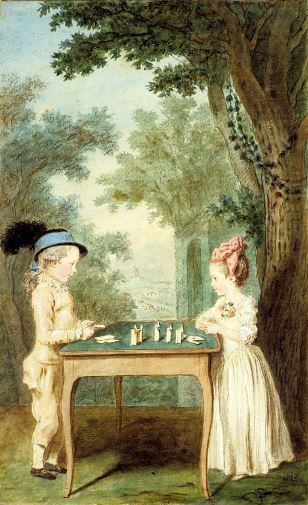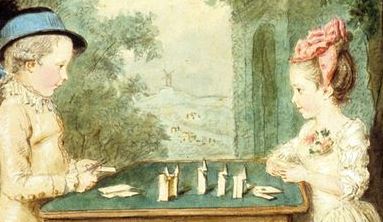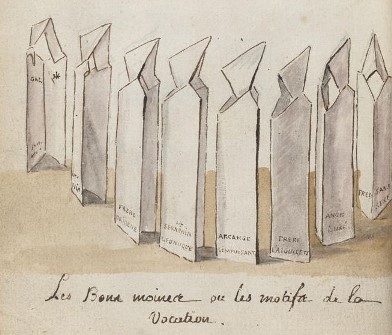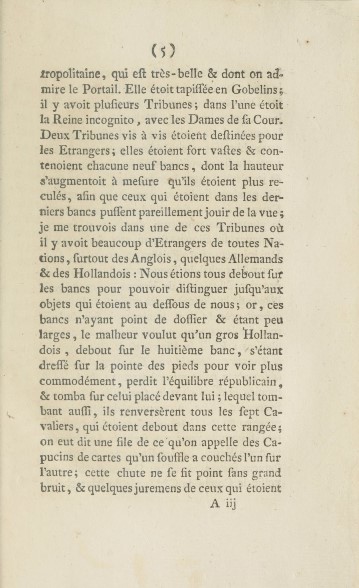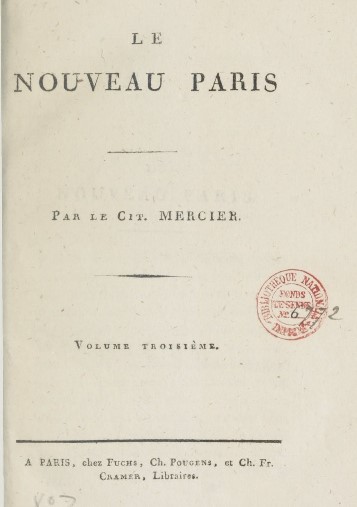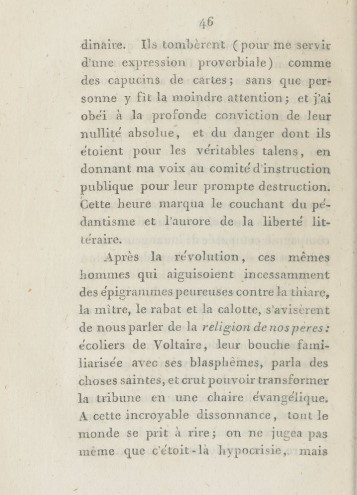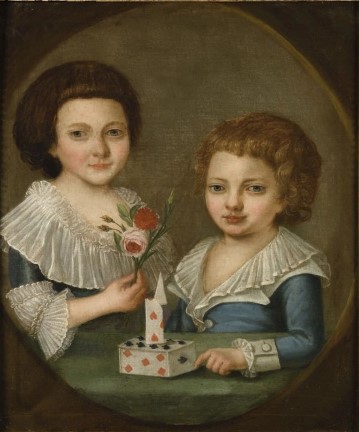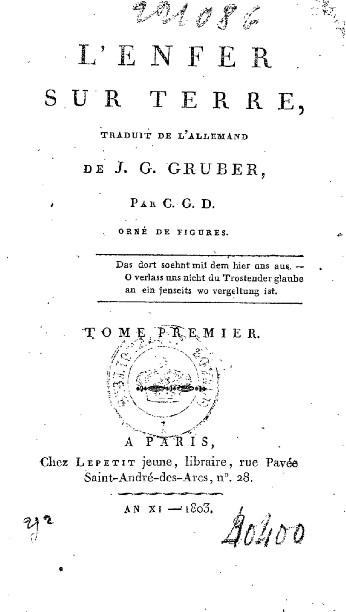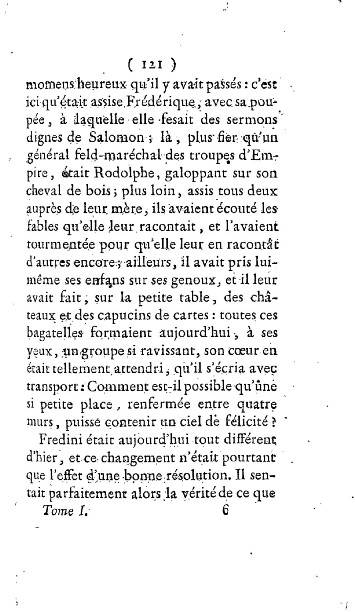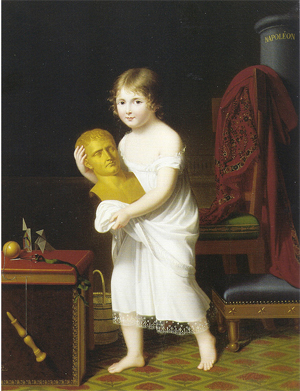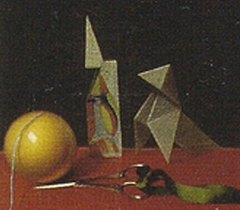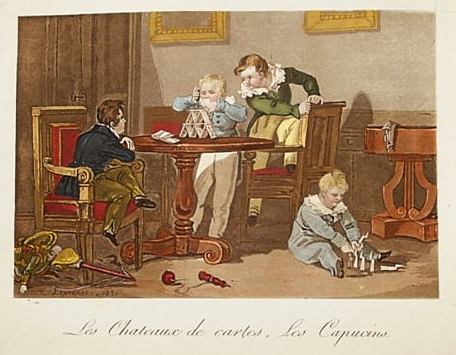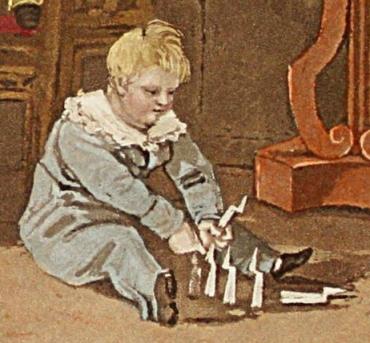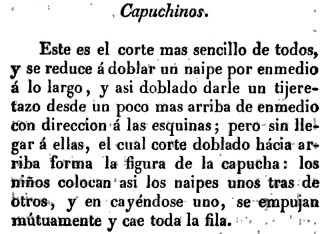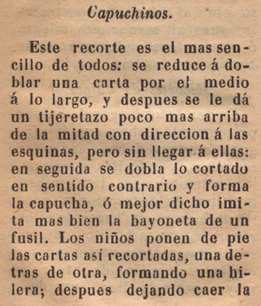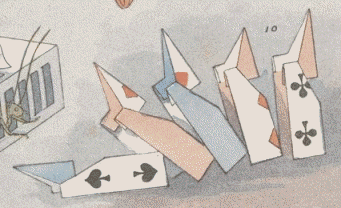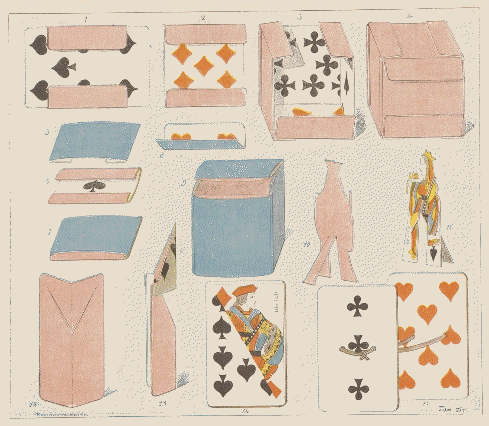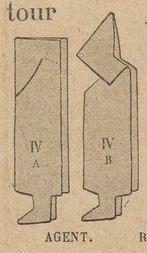| The Public Paperfolding History Project
Last updated 18/2/2024 x |
|||||||
| The Playing Card Monk / Capucin de Cartes / Capuchinos | |||||||
| This
page is being used to collect information about the
history of the fold and cut design variously known as the
Playing Card Monk / Capucin de Cartes / Capuchinos.
Please contact me if you know any of this information is
incorrect or if you have any other information that
should be added. Thank you. There are many references to capucins de cartes in French literature. A search on Gallica for "capucins" located at a maximum distance of 2 word(s) from "cartes" gives 80 pages of results, the phrase 'tombent comme des capucins de cartes' having become a cliche in France. I have only recorded a few of these instances before 1800 on this page, unless there is some other special reason to do so. ********** 1740 to 1760 As far as I know this fold and cut design first appears in the historical record in a watercolour entitled 'Le Petit de Chevilly et Sa Soeur' by Louis Carrogis de Carmontelle which is held at the Winterthur Museum and can be dated to between 1740 and 1760. The male child is holding scissors in his hand in order to make the cut on which the design depends.
********** 1740 to 1775 Capucins de Carte also feature in this drawing by Charles-Germain de Saint-Aubin (1721 - 1786) entitled 'Les bons moines, ou les motifs de la vocation from the book 'Le Livre de caricatures tant bonnes que mauvaises' (Good monks, or the motives of vocation). Information from Emmanuel Nivon. More details about this drawing can be viewed at Les Bons moines, ou les motifs de la vocation. - Waddesdon Manor. Note particularly the Commentary. According to this site, the drawings in the book can be dated to between 1740 and c1775.
********** Prior to 1775 The Playing Card Monk design also occurs in a painting by François Hubert Drouais (French, 1727–1775) titled 'Boy with a House of Cards'. I do not know when this picture was painted but it can be no later than 1775 when the painter died.
********** 1777 'Les Gémeaux, parodie de Castor et Pollux ; en trois actes, ariettes et vaudevilles, avec spectacle et divertissements' by Pierre Thomas Gondot, was published in Paris in 1777. There is a stage direction which says 'Ils tombent comme des Capucins de cartes'. (They fall like Capuchins of cards.)
********** 1785 'Lettres sur la France, l'Angleterre et l'Italie' par le Cte F. d. H. (François de Hartig) (1758-1797), which was published in Geneva in 1785, contains mention of Capucins de Cartes. which, roughly translated, says: 'I was in one of these Tribunals where there were many foreigners of all Nations, especially Englishs, some Germans & Hollanders: We were all standing on the benches to be able to distinguish even the objects that are below us; now, these benches having no back & being not very wide, misfortune wanted that a big Hollander, standing on the eighth bench, having stood on tiptoe to see more conveniently, lost the republican balance, & fell on the one placed in front of him; which too they overthrew all the seven Cavaliers, who were standing in this row; a line of so-called capucins of cards had been said to have been said to have been laid on top of each other; this fall was not without much noise ...'
*********** 1786 'L'ane promeneur, ou Critès promené par son ane ; chef-d'œuvre pour servir d'Apologie au goût, aux mœurs, à l'esprit, et aux découvertes du siècle' by Antoine-Joseph Gorsas (1751-1793) was published at Pamplona in 1786. It contains mention of capucins de cartes: 'One of the Sleepers who has his head back, after an indecisive sway of a few seconds, loses his balance, and letting himself fall on his neighbor, at the same time he shoots down a string of heads that fall on the shoulders of each of those to whom they belonged, more or less like capucins de cartes.'
********** c1787 Playing Card Monks also appear in a painting titled 'Famille Mégret de Sérilly' by Jacques Thouron which can be dated to c1787.
********** 1790 'La Pariséide ou les Amours d'un jeune patriote et d'une belle aristocrate' was published in Paris in 1790. It contains the passage: 'Ainsi qu'on voit souvent un enfant de famille ranger sur une table des Capucins de cartes, et pousser le dernier pour faire tomber tous les autres'. (As we often see a child of a family arranging on a table Capucins of cards, and pushing the last to bring down all the others'.)
********** 1793 'Almanach littéraire ou Etrennes d'Apollon' was published in Paris in 1793. It contains a sentence wich reads 'RÉJOUISSEZ-VOUS , les préjugés tombent comme des capucins de cartes.' (REJOICE, prejudices fall like capucins de cartes).
********** 1797 'Le nouveau Paris. Volume 3' by Louis-Sébastien Mercier (1740-1814) was published by Fuchs, C. Pougens et C. F. Cramer in Paris in 1797. It contains the sentence, 'Ils tombèrent ( pour me servir d'une expression proverbiale) comme des capucins de cartes' (They fell (to use a proverbial expression) like capucins de cartes).
********** Prior to 1799 The only information given about this painting, which also shows the Playing Card Monk, was French School, 18th Century, so I have allocated it to the last year of that period, although it is probably considerably earlier.
********** 1803 'L'Enfer sur terre, traduit de l'allemand' by C. G. D, translated by J. G. Gruber, was published in Paris in 1803. It contains the passage 'il avait pris lui-même ses enfans sur ses genoux, et il leur avait fait, sur la petite table, des châteaux et des capucins de cartes'. ('he himself had taken his children on his lap, and he had made them, on the small table, castles and capuchins of cards')
********** 1806 The design also appears in a painting by Jeanne-Elisabeth Chaudet-Husson (1767 to 1832) entitled 'Marie-Laetitia Murat portant le buste de Napolean', which can be dated to 1806. This picture also shows a folded Cocotte.
********** 1822 A boy playing with Capucins de cartes is featured in this picture from 'Les Jeux de Jeunes Garcons', illustrated by Xavier Le Prince (otherwise known as Xavier Leprince), which was published in Paris in 1822, although the drawings are dated 1821. Information from Juan Gimeno.
The accompanying text reads 'The cards offer children amusements of more than one kind; they make castles, boxes, chains, little cutouts they call capuchins; they place these so that if one drops, all the others fall in a row.'
********** 1827 A written description of how to make 'Les Capucins' / Playing Card Monks from folded playing cards with a single diagonal cut (and how to use them as skittles to play the game of domino rally), appears in 'Manuel Complet des Jeux de Société' by Elisabeth Celnart, which was published by La Librairie Encyclopedique de Roret in Paris in 1827. Roughly, 'Here is the simplest cutting of cards: wide at one end, pointed at the other, and slightly curved at the top, to keep it in balance, the Capuchin, which resembles a rifle bayonet, is a sort of card skittle; indeed, the children plant the Capucins close to each other, and when one falls, the others fall in a row.'
********** 1830 There is a reference to Capucins des Cartes in a cartoon by Jean-François Villain, published in Paris in 1830. The wording below the cartoon reads: 'Les Capucins des Cartes ou le Jeu des Enfants de Paris les 27. 28 et 29 Juillet 1830'. Information from Edwin Corrie.
********** 1831 'Manual completo de juegos de sociedad o tertulia y la prendas', translated by Frances for D. Mariano de Rementería y Fica, which was published by Palacios in Madrid in 1831, contains a translation of the material about the Playing Card Monk which appeared in Celnart (see above).
********** 1847 A similar description also appears in 'Juegos de los Ninos', which was published in Madrid by R y Fonseca in 1847. The final sentence says, roughly, 'The children stand the cards up, one after the other ... then, dropping the first, they push each other over and all of them fall in succession.'
********** 1872 'Pâquerettes et soucis : poésies intimes' by Jules Coste, which was published in Paris in 1872, contains the words 'capucins de cartes, des cocottes en papier'.
********** 1884 Both the design and its use as skittles in a game of similar to the game now usually played with dominos are illustrated in 'Jeux et Jouet du Jeune Age' by Gaston Tissandier, which was published by G Masson in Paris in 1884.
********** 1894 The design also appears in a section devoted to toys made from playing cards in 'Pour Amuser Les Petits' by Tom Tit, which was published in Paris in 1894. (Bottom left of the page shown below.)
********** 1900 A version of the design appears, under the name 'Agent', in 'Mes Jolie Jeux' by Henriette Suzanne Bres, which was published by Librairie Hachette in Paris in 1900.
********** |
|||||||
